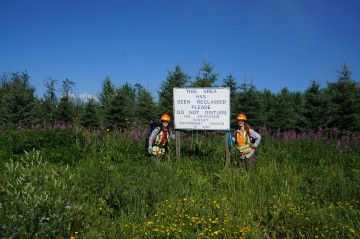Congratulations to Jacynthe Masse, PRSSS Director of the BC Provincial Soils Initiative, for winning second place in the Best Student Presentation competition at the annual Canadian Society of Soil Science meeting, which was hosted in Banff, Alberta from May 4th through 8th! Jacynthe is a PhD student in the Belowground Ecosystem Group, supervised by Sue Grayston, in the Faculty of Forestry at the University of British Columbia.
Check out the abstract for her winning presentation below!
Restoring the nitrogen cycle in the boreal forest – a case study from Northern Alberta
By Jacynthe Masse, Sue Grayston, Cindy Prescott and Sylvie Quideau
The Athabasca oil sands deposit, located in the boreal forests of Northern Alberta, is one of the largest single oil deposits in the world. To date, oil sands mining activities have disturbed an area of about 715 square kilometres. Following surface mining, companies have the legal obligation to restore soil-like profiles that can support the previous land capabilities. Because of its importance for site productivity, re-establishment of the nitrogen cycle between these reconstructed soils and plants is one of the most critical factors required to insure long-term sustainability of reclaimed boreal landscape.
High nitrogen deposition recorded in the oil sands area combined with the high level of nitrate found in reclaimed soils raised concerns about the possibility of these reclaimed soils being in early stages of N saturation (Laxton et al, 2010), although little evidence of net nitrification in these reclaimed soils suggests the contrary (Laxton et al. 2012). To date, results on the behaviour of the nitrogen cycle in the reclaimed sites are contradictory. A systematic study of the nitrogen cycle is needed. Our research aimed at measuring the net rates of nitrogen transformations under different vegetation treatments in both reclaimed and naturally-disturbed (fire) sites.
Our results surprised us as they showed not differences between the reclaimed and the naturally- disturbed sites in exchangeable ammonium and nitrate concentrations, net ammonification and net nitrification rates. Total nitrogen was the only soil-characteristic for which we measured a clear difference between the two treatments. If we compared only the vegetation treatments within the reclaimed sites (deciduous, coniferous and grasses species) then, only the microbial biomass-N is different among treatments. These results are interesting as we hypothesized that there would be more differences among treatments. However, the differences for total N and microbial biomass N could be due to underlying mechanisms undetected by the methods we have used so far. Our next steps will be to look at gross rates of N-transformation and to fully characterize the microbial communities in these soils. This research is fundamental to our ability to restore boreal ecosystems after disturbance.

